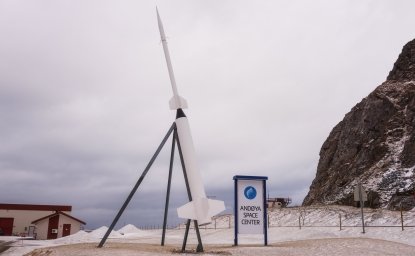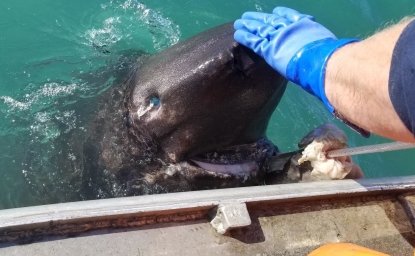Kennan Cable No. 73: Infrastructure in Russia’s Arctic: Environmental Impact and Considerations

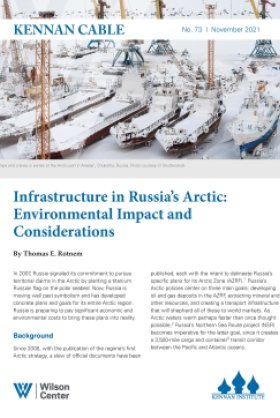
In 2007, Russia signaled its commitment to pursue territorial claims in the Arctic by planting a titanium Russian flag on the polar seabed. Now, Russia is moving well past symbolism and has developed concrete plans and goals for its entire Arctic region. Russia is preparing to pay significant economic and environmental costs to bring these plans into reality.
Background
Since 2008, with the publication of the regime’s first Arctic strategy, a slew of official documents have been published, each with the intent to delineate Russia’s specific plans for its Arctic Zone (AZRF).[1] Russia’s Arctic policies center on three main goals: developing oil and gas deposits in the AZRF, extracting mineral and other resources, and creating a transport infrastructure that will shepherd all of these to world markets. As Arctic waters warm perhaps faster than once thought possible,[2] Russia’s Northern Sea Route project (NSR) becomes imperative for the latter goal, since it creates a 3,500-mile cargo and container[3] transit corridor between the Pacific and Atlantic oceans.
To support the project, investments in a powerful new class of nuclear-powered icebreakers, underwater laying of fiber optic cables across the entire NSR, new and upgraded search and rescue stations, and map surveying of seabed along the NSR aquifer are all underway. Noteworthy onshore investments are also being made in the “feeder network” of rail, roads, and port facilities that will one day supply the NSR with the cargo and container goods that may help the Kremlin reach its goals of an annual 80 million tons transiting the NSR by 2024.[4]
It is truly startling to consider the number and scale of the projects being developed or planned in the near term in this feeder network. Rosatom’s director, Aleksei Likhachev, recently said the NSR feeder network projects are “perhaps developing at an even faster tempo than we had planned.”[5]
Yet, these same onshore developments may have serious repercussions for the environment and people living in Russia’s sensitive Arctic region. Although only 2.5 million people live in Russia’s sparsely populated AZRF, last May’s huge diesel spill by a Nornikel subsidiary in the Taimyr Peninsula negatively affected indigenous populations living along the Ambarnaya River. This tragedy may prove to be a cautionary tale for the government as it builds out the NSR feeder system.
Planned Infrastructure
The most important rail projects under active consideration in or near the AZRF are a line connecting Sosnogorsk in the Komi Republic to the port of Indiga in the Nenets Autonomous Region; a line connecting Karpogory in Arkhangelsk oblast’ with Solikamsk in the Perm Krai; and a line in the north of the Komi Republic (Chum) to Labytnangi in the Yamalo-Nenets Autonomous Region (YNAO).[6] Of greatest importance, however, is the Northern Latitudinal Railway (“Severnyi Shirotnyi Khod”), which was begun in the 1930s with gulag labor.
In April 2021, President Putin indicated in his address to the Federal Assembly that the two portions of this 438-mile railway, connecting the Northern Railway with Sabetta on the Yamal peninsula, and further east, connecting Labytnangi with Nadym and the existing Sverdlovsk Railway, will create a continuous transport linkage in the southern portions of the YNAO that will allow the export of hydrocarbons, minerals, and other resources from the interior of the oil-rich region.
The total cost of the project is set to exceed $3.6 billion, while the volume of cargo transit is set to increase by almost 24 million tons annually, with much of this being exported through Sabetta and the NSR. YNAO Governor Dmitrii Artiukhov recently applied for a $715 million infrastructure budget loan from federal authorities, indicating an intended 2022 construction start date and planned completion in 2027. Earlier, at a government meeting in Salekhard, Minister of Economic Development Maxim Reshetnikov reportedly looked favorably upon such financing pathways, arguing that the National Wealth Fund should be tapped for such important national projects.[7]
In terms of roadways to be built in the AZRF, the government plans three new or improved Arctic roadways from Nar’yan-Mar in the Nenets Autonomous Okrug to Usinsk in the Komi Republic and the Arkhangelsk-Onega roadway in Arkhangelsk oblast’. Each of these are at different stages of planning or completion. In addition, the 1,100 mile inter-regional road linking the Kolyma river in Siberia to Anadyr’ in the Pacific northeast of the country, under development since 2011, will tie Magadan oblast’ to Chukotka Republic, bringing minerals and resources from the interior to port.[8]
Improvements to existing ocean ports and river ports are another part of the plan to develop the feeder network spiriting cargo into the NSR, or via the Northern Sea Transit Corridor.[9] Plans today foresee the dramatic expansion or improvement of 11 ocean ports, from Provideniia in the far east of the country to Belokamenka in Murmansk oblast’. Situated to the north of Murmansk, Belokamenka port will be Novatek’s enormous LNG supply plant and is currently the largest construction site in the Arctic north. Enhancements to 11 river ports or systems will contribute to the portage of resources from the interior of the country northward into the NSR. The Ministry of Transport is preparing an “Internal River Transport” document, which, when completed in 2022, will not only attempt to lower the average age of Russia’s river shipping fleet, but also develop cargo nodes along 11 major and minor rivers and waterways.[10]
In addition to these feeder network projects, plans are underway to drill for oil and gas in a host of new fields in the YNAO and Krasnoyarsk Krai. Among the most ambitious projects is Rosneft’s Vostok Oil, set to exploit a six billion ton, low-sulphur oil deposit, which will supply the new “Sever Bay” oil terminal south of Dikson with 115 million tons of oil per year, all bound for the NSR. Moreover, in an increasingly tight hydrocarbon market, Russian oil and gas companies are now actively exploring offshore further eastward, in areas in the Laptev, East Siberian, and Chukchi seas which have not heretofore gained much attention.[11]
Furthermore, within the last year, a plethora of new Arctic mining and industrial projects have been announced or undertaken, from the development of the Tomtor rare earths metals fields in Yakutia and the Afrikanda titanium and rare earths metals deposits in Murmansk oblast’ to the development of Nornikel’s new “Big Copper” plant in Monchegorsk and a pulp and paper mill in Arkhangelsk. Perhaps among the most environmentally destructive of these, however, will be the Syradasaiskoe coal deposit currently being developed in the Taimyr Peninsula in far northern Krasnoyarsk Krai. Here, the Northern Star Company will process seven million tons of coal per year, all of it to be exported via a 60-kilometer road which links the deposit and enrichment plant with the new coal terminal “Yenisei,” south of Dikson.[12]
Stimuli for Recent Development Activity
One of the main reasons for the dramatic increase in infrastructure and development projects in the Arctic is the passage of Federal Law No. 193-F3 in July 2020, “On State Support of Entrepreneurial Activity in the AZRF.” The law creates Russia’s Arctic as a special economic zone, wherein the state subsidizes economic activity and provides generous tax incentives for new investment. Any entrepreneur ready to invest at least one million rubles in Arctic projects can gain resident status, and that provides tax breaks and other preferences. For example, such economic activity is exempt from any federal tax obligations (and lower regional and municipal taxes, too) for the first 10 years of profitability. Additionally, the law reduces rates on required insurance premiums, while the inspections regime for new investment projects are simplified. Moreover, the current mineral extraction tax rate is decreased by half.[13]
Besides the new legal basis, the reshuffle of a variety of Russian government officials on November 10, 2020 also paved the way for increased investment activity and government interest in the Arctic region. For one, former Energy Minister Alexander Novak was elevated to Deputy Prime Minister in charge of the entire fuel and energy complex. Alexander Kozlov (a protégé of Deputy Prime Minister, Presidential Envoy to the Far Eastern Federal District, and Chairman of the Arctic Commission Yuri Trutnev) was made Minister of Natural Resources and the Environment. Aleksei Chekunkov, former general director of the Far East and Arctic Development Fund, was appointed Minister of Development for the Far East and the Arctic. As a result of the new legal basis for the “Arctic concession” and these new appointments, a total of 186 new Arctic residents have been registered with authorities, and approximately 268 billion rubles have been invested in development projects.[14]
Environmental Impact and Implications
These infrastructure and development projects pose a serious threat to the environment of the Arctic, a region that, because of its cold temperatures, takes longer to regenerate in the wake of any industrial spill or negative environmental impact. Beyond the clear-cutting and railbed or roadbed leveling in preparation for construction of railways and roadways, diesel emissions, cargo dust, and rail wheel breaking pollutes both the air and soil. Water pollution frequently results from leaking fuel storage tanks and herbicides that are used on roadbeds. Railway and roadway construction leads to soil erosion and negative riparian effects. The noise and vibration from transport can affect the migration patterns of certain animals and many bird species.[15] Dredging for the construction, expansion, or improvement of ocean or river ports not only releases harmful contaminants into the water, but also introduces numerous stressors into the aquatic environment, dramatically impacting fish habitat and mortality.[16] Of course, increased mining activity and the extraction, processing, and transport of ever more oil and gas product will create even greater adverse impacts upon Russia’s Arctic environment.
Such environmental consequences may be politically costly for the Russian government, especially in an election year. A series of polls conducted in 2020 indicate that the population believes that the country’s ecological situation continues to worsen. The polls also indicate that the public may be more likely to take part in demonstrations that have an environmental, rather than an overtly political, purpose.[17] Given this, might elites worry that an otherwise atomized and politically apathetic populace could be stirred by an especially damaging industrial accident, perhaps one that might be several times as deleterious as the May 2020 diesel fuel spill on the Taimyr Peninsula? Russia’s Chairmanship of the Arctic Council for the 2021–23 period and the new decarbonization policy of the European Union act as further incentives for the Russian government to toe a greener line.
To be sure, the Russian government has paid increasing attention to the environment, beginning with a national project initiated in 2018 focusing upon ecology.[18] Government consideration of the environment has increased considerably since last year’s devastating Norilsk spill and the mass mortality event as a result of the Kamchatka red tide.[19] Emblematic of this renewed focus was the unusual public criticism of Norilsk officials late last year by Federation Council Chairwoman Valentina Matvienko, who lambasted them for their “sheer cynicism and indifference.”[20]
In the spring and summer of 2021, the Duma passed several laws concerning the environmental monitoring of greenhouse gas emissions, including laws that require all companies to monitor the environmental impact of their operations. In addition, the new national security directive published in early July for the first time highlights ecological security as an important national interest.[21] Additional laws under consideration will compel oil companies to pay for damage to the environment, and such damages must be used for environmental recovery actions rather than being directed to general state coffers. According to Svetlana Radionova, head of Rosprirodnadzor, the state’s environmental protection agency, legislation is also being assembled for the fall Duma session that would dramatically increase fines for harming the environment and allow for the removal of oil company executives in the event of large oil spills.[22]
Arctic “Greenwashing?”
Despite these displays of governmental concern for the environment, the scope and scale of infrastructure and development plans and investment in the AZRF will no doubt lead to serious harm to pristine Arctic environments. This is especially true because for transport and communal construction, as well as for certain types of oil and gas borehole drilling, the requirement to obtain an expert environmental impact assessment has been waived by legislation passed recently. Of the 19 AZRF resident members of the Public Council of the Ministry of the Far East and the Arctic—the body whose purpose is to protect the interests of fellow Arctic citizens when reviewing plans for development projects—only one of them has no apparent ties to regional or national government, state-owned corporations, state-supported public universities, or other “captured” entities.[23] In addition, at a recent conference on sustainable development, Arctic Commission Chair Yuri Trutnev stated that renewable energy may be useful in certain parts of Russia, “but one must understand, that in far-flung regions of Russia, especially in the northern Arctic zone, it is impossible to effectively use renewable sources of energy” in production processes.[24]
What Comes Next?
Regardless of the environmental costs of the feeder infrastructure projects onshore, questions remain concerning the overall financial feasibility of the NSR. For one, the projected volume of 80 million tons of cargo and containers navigating the route in 2024 represents only a little over 20 days of global shipping transiting the Suez Canal. Will this level, or even that planned by 2030, justify the massive investments in upgrading and expanding the aquatic and feeder network infrastructure, especially considering Russia’s taxing problem of corruption in major public works projects? Will container shipping lines adopt the route, given the substantial problems—such as inclement weather, long wait times for icebreaker escort, shallow drafts in Russia’s eastern Arctic seas—that may affect delivery schedules? Will significant additional permafrost melt cause serious further decay in both existing and planned onshore infrastructure investments?
Conclusion
Among gargantuan economic plans devised by Soviet or post-Soviet governments, the full development of the Northern Sea Route commercial artery stands out as one of the biggest long-term construction projects ever undertaken. The goal of reaching 80 million tons of cargo delivered along the route by 2024, and 150 million tons by 2030, are regularly trumpeted in official speeches. At the beginning of the Eastern Economic Forum in Vladivostok in September, President Putin announced that regular year-round cargo transportation between St. Petersburg and Vladivostok would start on a test basis in 2022. Yet, container transit between Asia and Europe will perhaps only amount to a quarter of the 80 million target by 2024. To reach Putin’s oft-mentioned goal, the remaining cargo will have to come from within Russia’s resource-rich northern regions, borne along feeder networks of rail, road, and river transport.
In the last year, a mixture of Russian public and private investment monies have funded the development of new railway, road, and port improvements in the AZRF, as well as new Far North mining, oil, gas, and other projects, ventures that will soon deliver additional cargo to the NSR. What will the impact be upon Russia’s environment in the Arctic? Despite an apparent authentic government focus on environmental problems more recently, it is doubtful that a real “greening” of the government’s plans in the Arctic will come to pass.
The opinion expressed in this article are those solely of the author.
[1] Osnovy Gosudarstvennyoi Politiki Rossiiskoi Federatsii v Arktike na period do 2020 goda I Dal’neishuiu Perspektivu,” March 27, 2009, RG.RU, https://rg.ru/2009/03/30/arktika-osnovy-dok.html; Decree of the President of the Russian Federation from 2.05.2014, No. 296, “On the Land Territories of the Arctic Zone of the Russian Federation,” http://www.kremlin.ru/acts/bank/38377; State Program of the Russian Federation, “Social and Economic Development of the Russian Arctic Zone until 2020” approved by the Decree of the Government of the RF on April 21, 2014, No. 366, Official site of the State Commission for the Development of the Arctic, https://arctic.gov.ru/FilePreview/7ca1c8fc-eb5a-e511-8262-10604b797c23?nodeId=4370391e-a84c-e511-825f-10604b797c23; and Decree of the President of the Russian Federation from 10.26.2020, No. 645, “On the Strategy for the Development of the Arctic Zone of the Russian Federation and Supporting the National Security until 2035,” http://kremlin.ru/acts/bank/45972
[2] Intergovernmental Panel on Climate Change, Climate Change 2021: The Physical Science Basis—Summary for Policymakers (Nairobi, Kenya: UN Environment Programme, August 9, 2021).
[3] Cargo shipping refers to vessels carrying freight items like chemicals, fertilizers, minerals, agricultural products, machinery, and vehicles. Container shipping normally refers to vessels that carry loads in large intermodal containers, in which objects, furniture, garments, or data can be stored.
[4] By 2030, that figure is slated to increase to 150 million tons annually. For comparison, in 2020, almost 33 million tons of cargo and container goods transited the NSR.
[5] Sergei Dianov, “Putin Nashyol Soiuznikov dlia Bor’by s Davleniem Zapada,” August 4, 2021, URA.RU https://ura.news/articles/1036282782
[6] Reconstruction work will also commence further south, along a line connecting portions of the Komi Republic to Arkhangelsk oblast’. Decree of the President of the Russian Federation from 10.26.2020, No. 645, “On the Strategy for the Development of the Arctic Zone of the Russian Federation and Supporting the National Security until 2035,” http://kremlin.ru/acts/bank/45972
[7] Minister Ekonomicheskogo Razvitiia Rossii Provyol v Salekharde Soveshchanie o Stroitel’stve Severnogo Shirotnogo Khoda,” August 14, 2021, Pravitel’stvo IaNAO, https://www.yanao.ru/presscenter/news/75320/; and Iamal Podal Zaiavku na Infrastrukturnyi Kredit v 50 mlrd rub. dlia Severnogo shirotnogo khoda, August 29, 2021, Arktika Onlain channel, Telegram app.
[8] The government plans to build another road in the Komi Republic, linking Syktyvkar to Usinsk, via Ukhta. “Uchastok dorogi Kolyma—Anadyr’ cdadut v 2021 godu,” September 10, 2020, TASS, https://tass.ru/obschestvo/9426089
[9] Officially, the NSR starts at the Bering Strait and ends at the Kara Strait, a body of water separating Novaya Zemlya from the Russian mainland. Thereafter, westward movement by ships from the Kara Strait through the Barents and White Seas (e.g., toward either Murmansk or Arkhangelsk) enters the Russian “Northern Sea Transit Corridor.”
[10] The waterways include the Belomor-Baltic Canal, as well as the Onega, Mezen’, Pechora, Ob’, Yenisei, Lena, Iana, Kolyma, Anabar, and Indigirka rivers. Rukovoditel’ Rosmorrechflota o gotoviashchemsia Natsproekte po Razvitiiu Vnutrennego Vodnogo Transporta, November 17, 2020, http://morflot.gov.ru/novosti/publikatsii_i_intervuy/f3761.html; and Rukovoditel’ Rosmorrechflota rasskazal o razvitii navigatsii-2021 i osnovnykh zadachakh otrasli, July 30, 2021, http://morflot.gov.ru/novosti/publikatsii_i_intervuy/f4009.html
[11] In June 2021, Gazprom-Neft’ and Novatek signed a joint venture agreement to exploit offshore oil and gas deposits to the north and east of Wrangel island, in the Chukchi Sea. “’Gazprom-Neft’’ I ‘NOVATEK’ sozdaiut sovmestnoe predpriiatie dlia raboty na arkticheskom shel’fe,” June 4, 2021, https://www.gazprom-neft.ru/press-center/news/gazprom_neft_i_novatek_sozdayut_sovmestnoe_predpriyatie_dlya_raboty_na_arkticheskom_shelfe/
[12] Rivaling the Kuzbass coal deposit, the Syradasaiskoe coal field contains over six billion tons of coal, much of it planned for export to China and other Asian countries. “Rezident AZRF Zavershaet Stroitel’stvo Avtodorogi na Taimyre dlia osvoeniia Syradasaiskogo Mestorozhdeniia Uglia,” August 12, 2021, Yakutsk.ru, http://yakutsk.ru/news/Transport_i_svyaz/rezident_azrf_zavershaet_stroitelstvo_avtodorogi_na_taymyre_dlya_osvoeniya_syradasayskogo_mestorozhd/?utm_source=yxnews%Futmtop3
[13] “Putin podpisal zakon o l’gotakh dlia biznesa v Arktike,” July 13, 2020, Kommersant,’’ https://www.kommersant.ru/doc/4416226; and “O gosudarstvennoi podderzhke predprinimatel’skoi deiatel’nosti v Arkticheskom zone Rossiiskoi Federatsii,” July 13, 2020, http://publication.pravo.gov.ru/Document/View/0001202007130047
[14] Aleksandr Stotskii, “Arktika segodnia: zakon o l’gotakh kak faktor razvitiia,” August 25, 2021, Goarctic.ru, https://goarctic.ru/news/arktika-segodnya-zakon-o-lgotakh-kak-faktor-razvitiya/
[15] Priscila Silva Lucas, Ramon Gomes de Carvalho, and Clara Grilo. 2017. “Railway Disturbances on Wildlife: Types, Effects, and Mitigation Measures,” Railway Ecology, https://doi.org/10.1007/978-3-319-57496-7_6
[16] Amelia S. Wenger et al., “A Critical Analysis of the Direct Effects of Dredging on Fish,” Fish and Fisheries 18 (2017): 967–985, https://onlinelibrary.wiley.com/doi/epdf/10.1111/faf.12218
[17] Elena Mukhametshina, “Polovina rossiian schitaet, chto ekologicheskaia situatsiia v Rossii za poslednie gody ukhudshilas,’” November 20, 2020, Vedomosti, https://www.vedomosti.ru/society/articles/2020/11/29/848723-polovina-rossiyan
[18]“Pasport Natsional’nogo Proekta ‘Ekologiia,’” 2018, https://www.mnr.gov.ru/activity/directions/natsionalnyy_proekt_ekologiya/
[19] Sergei Vinogradov, “Kto otvetit za ekotsid na Kamchatke?” December 21, 2020, Novye Vedomosti, https://nvdaily.ru/info/199526.html
[20] “Valentina Matvienko o deistviiakh ‘Nornikelia,’” YouTube video, October 21, 2020, https://www.youtube.com/watch?v=ENhycQBt04Y
[21] Decree of the President of the Russian Federation from 7.02.2021, No. 400 “On the Russian Federation’s Strategy for National Security,” http://publication.pravo.gov.ru/Document/View/0001202107030001
[22]Diana Reshetniak, “Svetlana Radionova: Ia protiv repressii, no u rossiian zapros na povyshenie trebovatel’nosti,” August 8, 2021, TASS, https://tass.ru/interviews/12068087
[23] For example, the body is chaired by Grigorii Ledkov, who is also chairman of RAIPON, the organization ostensibly representing indigenous peoples’ interests. This organization was purged of government critics in 2013–15. Another member, Aleksei Kazanin, president of the Murmansk Association of Polar Explorers, is apparently an independent actor, but he is also director of a company that performs mapping services for the NSR’s underwater basin. Perhaps the only actual independent voice on the body is Yuri Rybakov, who is the chairman of a Karelian sustainable development environmental organization.
[24]“Predstavitel’ prezidenta RF schitaet nevozmozhnym effektivnoe ispol’zovanie VIE v Arktike,” July 15, 2021, Arktika Onlain channel, https://t.me/Arctik_Obline/8775, Telegram app.
Author

Professor of Political Science and Associate Director, School of Government and International Affairs, Kennesaw State University

Kennan Institute
The Kennan Institute is the premier US center for advanced research on Eurasia and the oldest and largest regional program at the Woodrow Wilson International Center for Scholars. The Kennan Institute is committed to improving American understanding of Russia, Ukraine, Central Asia, the South Caucasus, and the surrounding region through research and exchange. Read more

Explore More
Browse Insights & Analysis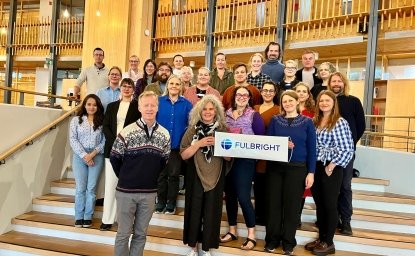
Fulbright Arctic Initiative IV Scholar at the Polar Institute
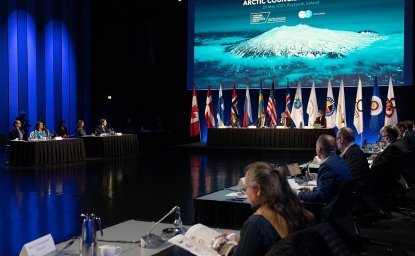
Trump 2.0’s Arctic Opportunity: Thawing Frozen Dialogue
